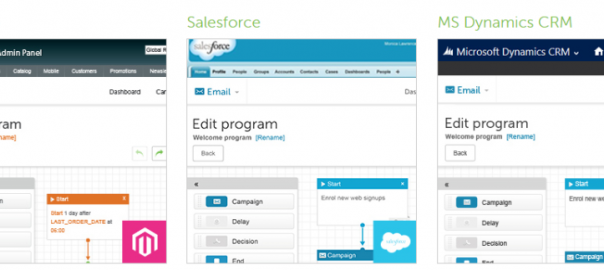Having worked at dotmailer almost a year, I thought it was about time I posted my first blog. In this two part blog I hope to distill the myth that CIOs and their IT staff are the ‘blockers’ to change. To the contrary, I’m of the view that they’re the advocates and can actually enable it to happen!
Coming from a background of IT leadership, I’m incredibly fortunate to have seen 15 years of change. It’s something you must love in IT and interestingly it has been part of my standard interview qualifying questions for IT staff for many years. For those outside the IT team looking in at their IT colleagues, there is however, a myth of them being completely adverse to change and causing friction between many a CMO and CIO.
In my experience, I’ve generally found it comes down to a single root cause. If you break down, to the simplest of explanations, IT systems are made up of billions of 1’s and 0’s. If even one of those 1’s or 0’s are not in alignment, it could behave in a different way from designed, not work at all, or potentially take down a load of other stuff which is critical to the operation of the business. Understanding this will ultimately help explain why CIOs and their IT teams need time, effort and concentration when working with you to achieve your marketing tech solutions. Not understanding this will likely lead to a lot of frustration, swearing and friction on why something just can’t be done today.
I’m now working as a CTO but in this blog I will draw upon my experience when I first arrived as a CIO (although much of this advice applies to both roles). So for this blog I asked myself this; what really made a difference to the success of an email marketing project when the CMO came to me as CIO?
1. Help the CIO understand why the marketing solution is needed
You need to explain how it fits into what the business strategy or goals are and what the success metrics look like.
I know what you’re thinking, ‘why are you questioning me about my marketing stuff? It’s not up to you to decide whether it goes ahead…” Indeed, the CIO is not there to ‘check your work’. The reason why this is important is it can enable a good start to the collaboration and buy-in of why this project is important to the business and how much time and effort can ultimately be assigned to make sure there is a good return on investment (ROI). Also looking holistically, it will enable the linking of the top level goals of the CMO and CIO’s objectives. In my first paragraph I talked about a set of numbers, IT folk are good with numbers, that’s our business, so demonstrating this can really aid buy-in. Any business would be mad to put a marketing solution in place without taking into account all the costs to implement and operate it. Your IT colleagues can assist the design, implementation and operational costs; however they will need your leadership…
2. Keep ownership of that project
CIOs and their IT team are not the other side of a wall waiting to catch projects generated from their CMO.
Any projects have to be collaborative and for me, the best projects have been led by the business area that has ownership. Therefore the CMO and their marketing team should keep ownership of the email marketing project at all times, whilst including the CIO as a key project team member. Larger IT teams will have business analysts (BA) and having them involved at the early stages of the project can really help map out the flow and requirements of what you’re trying to achieve. Putting in the ground work early with collaborative workshops will really help nut out the key information.
Again coming back to the 1’s and 0’s, the email marketing system won’t work to how it was designed if you haven’t implemented it the way you need it! Having IT involved from ‘cradle to grave’ ultimately pays off – there’s nothing worse for a CIO than having to get involved in a project halfway through its design or implementation. Even worse is a CMO being stuck with a system that doesn’t do what they wanted or is inflexible to change. Thinking forward, especially to multichannel, and how your current CRM, ERP or ecommerce systems are collating data is key to how you’re going to market in the future. Therefore being able to extract this data and integrate it into your ESP is going to be important for your CIO to get his head around.
3. The best IT systems in the world K.I.S.S…
…Keep It Stupidly Simple.
Building complexity in your business and marketing processes may ultimately have an adverse effect on your email marketing technology. Oddly, I have spent most of my career trying to implement simple systems that IT don’t need to babysit in live operations. Low administrative overhead is key to a good ROI and helping demonstrate this to CIOs will help. IT don’t want to look after the CMOs technology systems, they would much rather be working on the next project to solve the next problem. Pragmatism is important.
In a previous role, I once had to put a halt on a multi-million pound access control project, as the right solution, in my view, was actually ‘a man, a piece of rope and a some good common sense’ – but being serious, complexity should be rooted out where it is not adding value. Computers are not there to fix all problems and it’s important to know the problem you’re trying to solve, not the solution you want to put in to solve some problems you have.
No blog would be complete these days without the word Cloud, but this is where Cloud computing can really help. Here at dotmailer, we are a cloud-based solution for email marketers. Our mission is to build our Software As A Service (SAAS) platform to play well with others. Our service can give you sophisticated, complex marketing capabilities without the pain of on premise infrastructure and can still enable integration with your internal IT systems. Knowing that your email marketing solution has the ability to connect to other systems (e.g. Salesforce, Magento, Dynamics) out of the box and your own custom systems using our API, is key information a CIO will want to know and having this to hand will help your project. It’s also good to know that dotmailer can provide a Custom Integrations service to help with connecting up your systems, which can really help your CIO if they are constrained by their own internal BA and development resources.

4. IT strategy and policy is important and may impact your solution.
They’re usually there to protect your business and so these need to be factored in.
Your CIO is usually going to have a huge amount of responsibility and accountability in data protection and its security. These things do matter and have to be factored in, especially when you’re storing personal data. The CIO will want to know that these areas are being catered for in your email marketing project, so it’s worth making sure you understand what policies and practises are in place in your business. Many best practises should be embraced as ultimately these (plus country specific legislation on data protection) have been implemented for a very good reason and if they’re executed well they will help you gain a better ROI.
Understanding the IT strategy and roadmap will also play an important part of any email marketing project. A lot of the data you need will likely lie within business critical systems and if these are undergoing a major overhaul in the future there may be reluctance from your CIO to invest in new integrations to new technology. The trick here will be to work with your CIO on creating flexibility within the integrations so that they can be multipurpose as your business’ systems change, adapt, or if you decide to change ESP. Talking in this sort of language will hit home with your CIO as it will make that investment feel more worthwhile, with a better ROI, than a short term piece of development that may be thrown away. Understanding the technology roadmap and any periods where changes are frozen, will be useful when planning out your email marketing project, so these should be jotted down in the project plan.
5. GIGO (Garbage In = Garbage Out)
This is an age old CIO’s term, but it still stands true.
Having a massive list of your entire customer base that you email regularly is ‘old world’. You need a smaller list of your engaged customers, which you are ideally targeting based on the raft of good data you have on them. This data is ever growing and offloading this heavy duty processing to an email marketing provider such as dotmailer, will be good news for your CIO. This will mean they’ll no longer need to resource a database administrator to optimize/extract segments of your customer every time a new question is raised.
The world of ‘Big Data’ is challenging CIOs, especially with the Internet of Things around the corner. Storing data is not really the problem as storage is cheap, however being able to analyze larges volumes in real time is a headache they don’t want! Collecting and storing valuable customer insight data is incredibly important for targeted sends to your customers. Integrating this data to your ESP will enable this to happen. CIOs will want to see flexible integration capabilities from your ESP with good documentation on how they can create integrations using their own internal resource. There’ll be some acronyms that will pop up which you cannot get away from, so it’s good to start brushing up on them.
I hope you enjoyed tips 1-5, keep an eye out for part 2 for more ways to keep your IT happy, on board and keen to help with your marketing projects.
Digital & Social Articles on Business 2 Community(86)
Report Post



